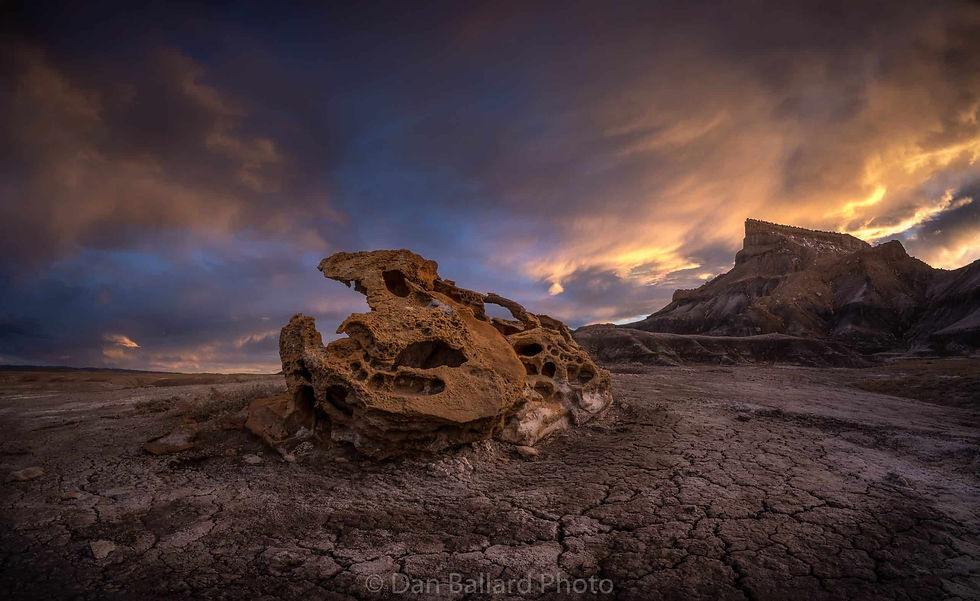Shooting, Fast and Slow: Two Modes of Thought
- danballardphotogra
- Jan 20, 2021
- 3 min read

You may have heard about the best-selling psychology book Thinking, Fast and Slow by Daniel Kahneman. It digs into the dichotomy between two modes of thought. “System 1” is fast, instinctive, and emotional; “System 2” is slower, more deliberative, and more logical. It intrigued me how these two systems are both active participants in the process of shooting and creating a landscape image. Even before reading the book, I’ve often pondered how photography can be both slow and calculated and also fast and unthinking. Or how some of my best images took 30 minutes to compose while others happened in a matter of seconds.
It’s not uncommon in the world of photography to hear someone say slow down. So often, beginner photographers tend to shoot without much thought. Simply taking the time to slow down to think and be incredibly aware of what you are attempting to capture is critical. That said, after years and years of shooting along with teaching hundreds of clients – I’ve learned that at times, shooting fast, without much thought is equally important. This article will attempt to explain why and when I feel shooting either slow or fast will be advantageous to create a great image.

Here are examples of scenes that required me to “slow down” and spend time to make sure every element worked together.
Shooting Slow (System 2)
As a beginner, everything starts out slow. Memorizing the buttons on your camera with your fingers. Unfolding your tripod into place. Remembering which settings to use and when. Learning about composition and design. It reminds me of learning to play guitar, as one of the most important lessons that you learn is to force yourself to play every riff excruciatingly slow with perfection over and over again until you can slowly speed up, getting faster while retaining perfect technique. Everything you do in photography needs to be done in a similar fashion. Be it on the artistic side or the technical.
Shooting slow is also about being completely aware of a scene even after you get more advanced. This is one of the most critical aspects I teach my workshop students – you have to give conscious and deliberate thought to each of the elements in your frame. How well do the various elements work together? Is one side of the frame more weighted? Is there simplicity? The more time you can spend practicing your awareness, moving the camera around the world, and analyzing everything in it – forcing yourself to identify different parts of the scene, the better able you will be to start doing it faster when the need arises.
All this in mind, I think there is a point in shooting slow where you can reach a plateau or get stuck in a rut – practicing the same techniques or formula over and over again. At this point, I think it is beneficial to experiment with shooting fast, letting your instinct and emotion guide you. Then you can revert to System 2 when it is time to master something new.

Shooting Fast (System 1)
There is a lot stored in subconscious, fast mind. Have you ever been immediately captivated by a potential photo that you saw in the blink of an eye, either while driving or walking by? Many of these types of scenes have caused me to turn around and go back, scenes that end up being some of my favorite images. All because it felt right. It’s been said that feeling is a form of thinking, both are ways we process information – but feeling is faster. This could also explain why we feel connected to certain places.
As explained in the book, System 1 thinking (or fast shooting) involves associating new information with existing patterns, or thoughts, rather than creating new patterns for each new experience. This would explain why shooting fast is about working what you already have in your knowledge bank, when the hours and hours of deliberate practice kicks in and can react instinctually. Using both the info from the learned patterns but also allowing intuition to guide. This would be why you can instantly recognize the elements that would make a great composition while passing by at 60mph.
READ THE FULL ARTICLE on Nature Photographers' Network!




















![5 Tips to Unlock Your Creative Potential [Guest Post]](https://static.wixstatic.com/media/e9de2c_de320547a8f743e4b4e784fd6ee94dc4~mv2.jpg/v1/fill/w_51,h_34,fp_0.50_0.50,q_90,enc_avif,quality_auto/e9de2c_de320547a8f743e4b4e784fd6ee94dc4~mv2.webp)
Comments